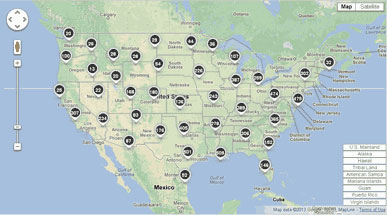Power plants are still the biggest source of greenhouse gas emissions in the US, now that the US Environmental Protection Agency (EPA) has calculated all sources for the second year.
In 2011, power plants were responsible for a solid third of greenhouse gas emissions, but their emissions dropped 4.6% from 2010 levels because of increased use of natural gas and renewable energy.
The second biggest polluting sector is petroleum and natural gas, followed by refineries.
Emissions rose in metals and chemicals production, but the good news is that overall, emissions from the biggest polluters dropped 3%.
In 2008, Congress mandated the Greenhouse Gas Reporting Program, which requires big polluters to report on their emissions each year. EPA allowed the industry to postpone reporting until 2010, the first year it enforced the program.
Now, everyone has access to this information on EPA’s website, which covers 8000 industrial plants across 29 industries, representing 85%-90% of all US greenhouse gas emissions. The only major industry that’s excluded is agriculture.
You can sort by geographic area, industry sector, type of greenhouse gas emitted and you can compare emissions among facilities. The information can be shared using social media tools such as Facebook and Twitter.

Under the law, facilities that emit 25,000 tons of carbon a year must report their emissions to the EPA. Reports include all greenhouse gases beside carbon: methane, nitrous oxide, hydrofluorocarbons, perfluorocarbons, sulfur hexafluoride and other fluorinated gases.
Regulating Existing Power Plants is Top Priority
When asked how President Obama can reduce greenhouse gases without Congressional legislation, number one on the environmental community’s list is for EPA to regulate power plant emissions.
Last year, EPA finally issued strong rules that limit greenhouse gas releases from new power plants. They would cut emissions by about half in new coal plants, bringing them into line with natural gas plants. There are plenty of loopholes though.
Now it’s time to regulate existing power plants.
Conservatives sued immediately when EPA issued regs for new power plants and they’re prepared to do battle if EPA extends them to existing plants.
"It they start trying to do this with existing plants, they’re going to have a real battle," Ed Whitfield (R-KY) told reporters.
"The new data confirms that the nation’s power plants, which churned out 2.2 billion tons of carbon pollution in 2011, should be the centerpiece of President Obama’s actions to reduce the threat of climate change," says David Doniger, policy director for the Natural Resources Defense Council Climate and Clean Air Program.
The organization has laid out a plan where state-specific standards would be set through the Clean Air Act. That would encourage investments in renewables and energy efficiency and reduce the US carbon footprint 10%, while creating thousands of jobs and cutting household utility bills about $700 a year.
Here’s the EPA’s emissions reporting website:
